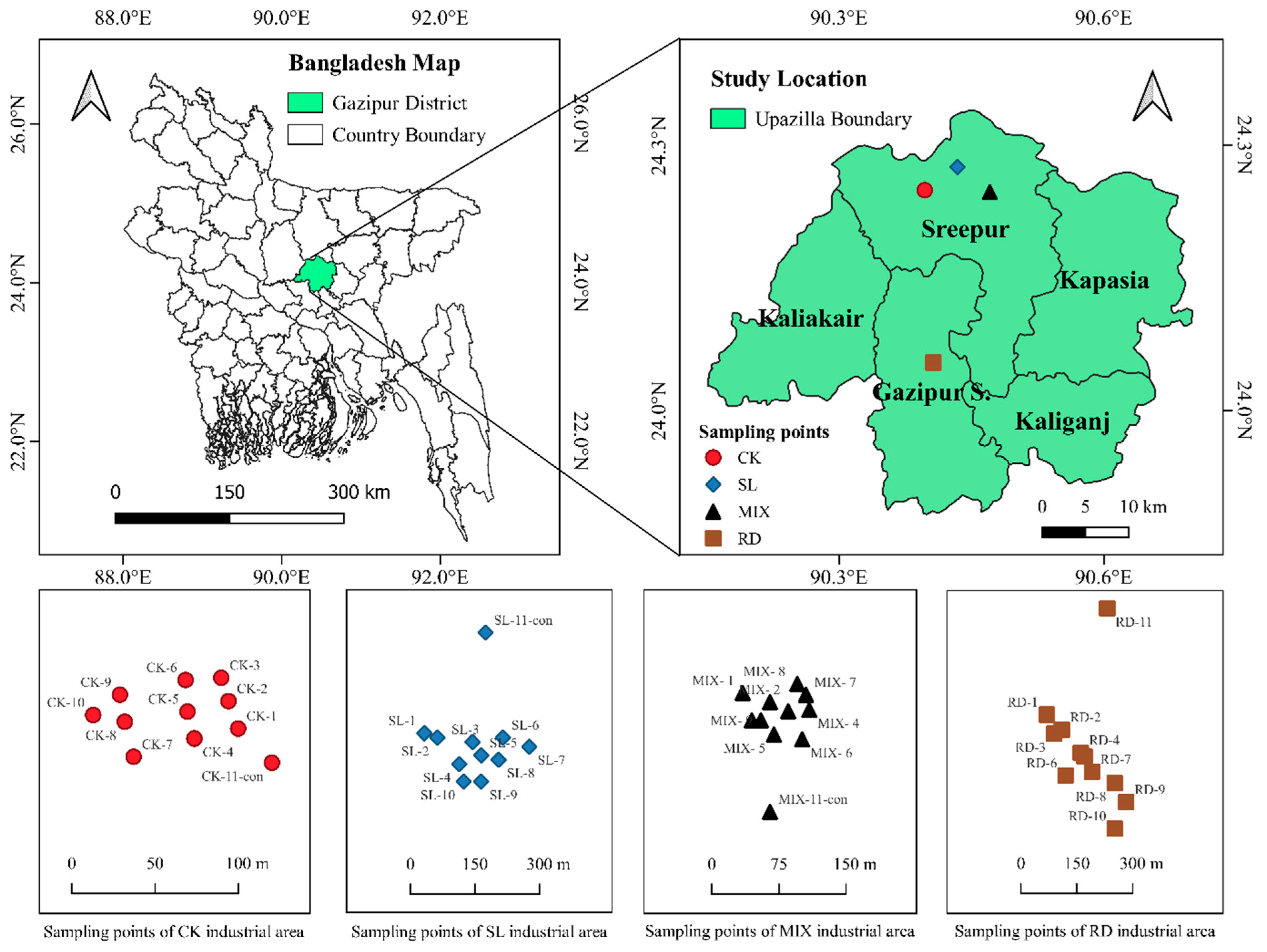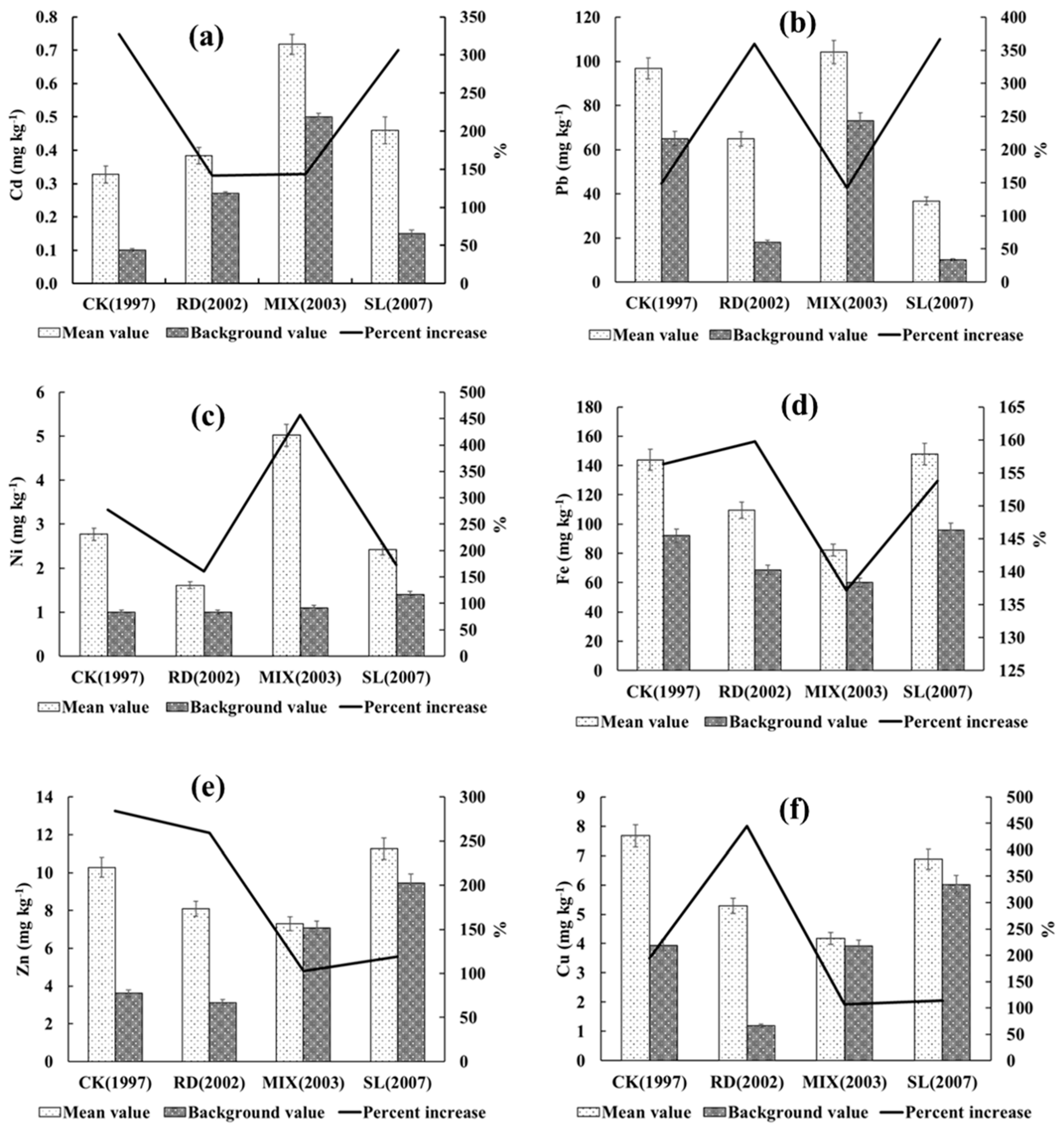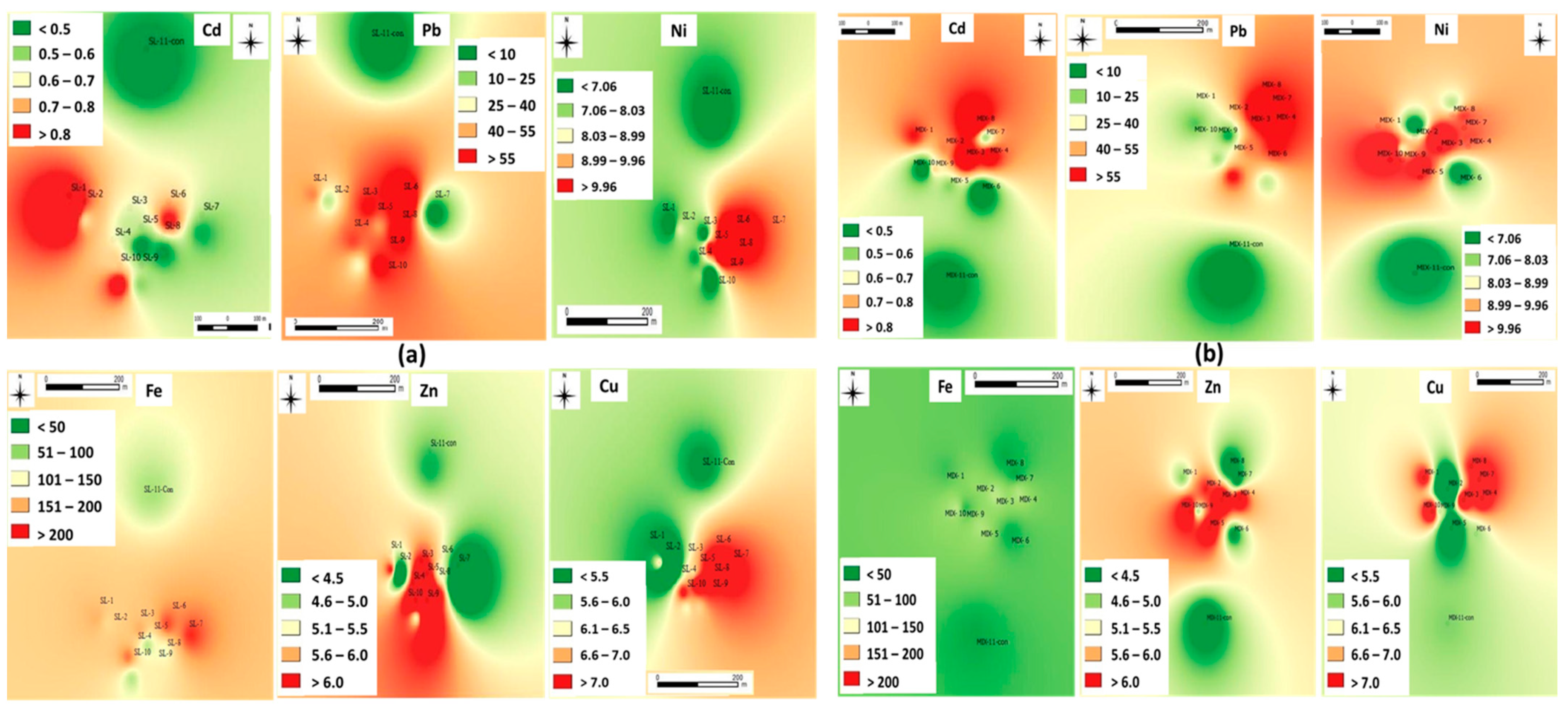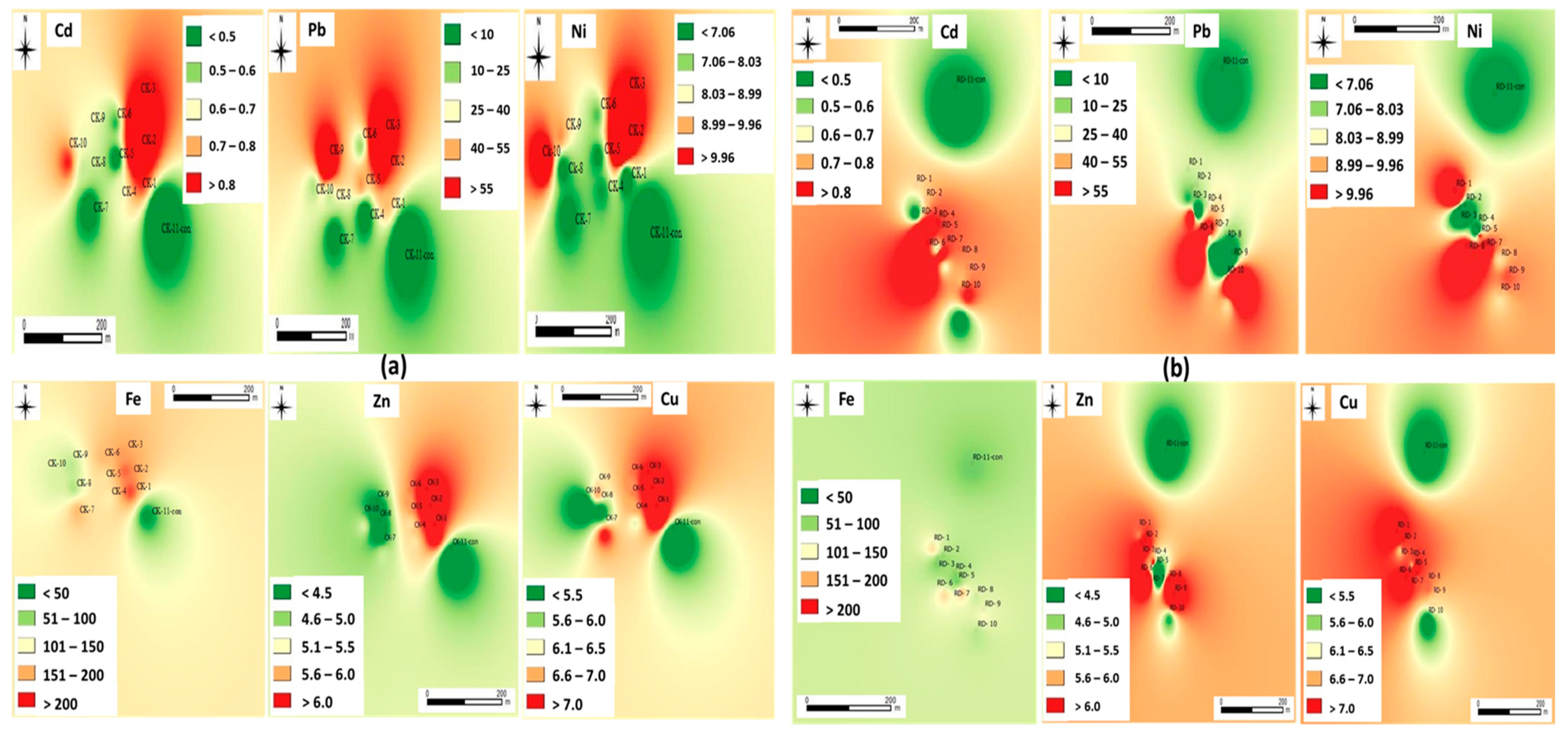1. Introduction
In recent years, much care has been paid to environmental pollution by means of rapid urbanization and industrialization throughout the world, and Bangladesh is part of this [
1,
2]. Owing to industrialization, the most serious environmental problem is the pollution of agricultural soil. A huge amount of wastewater generated from the industries has been discharged into the environment without appropriate treatments [
3,
4]. The spreading of these untreated heavy metals and contaminated effluents used for irrigation purposes could contaminate agricultural soils. Thus, heavy metal accumulation in agricultural soils has received serious attention due to potential health risks and their adverse effects on soil health, toxicity and persistence in the environment, and food safety issues as food chain contaminant through plant uptake [
5,
6,
7,
8,
9].
Anthropogenic activities such as mining, transportation, waste disposal, industrialization, and social and agricultural activities have significant impact on ecological pollution and the total ecosystem [
10,
11]. Different factors like climate, parent materials, mineralogy, and soil texture and type are involved in distributing heavy metals in nature [
12,
13]. However, various sources of untreated industrial wastewater are the main anthropogenic origin of heavy metals in the soil of Bangladesh [
14,
15,
16]. Irrigation with different sources of contaminated water such as industrial, municipal, and sewage sludge wastewater and the dumping of solid waste directly into farmland result in the spreading of untreated effluent throughout the farmland, and plants are exposed to poisonous metal ponds without any treatment [
17,
18,
19].
Many industries have been identified in the country by the Department of Environmental Promotion (DoE) which do not have sewage and waste treatment facilities [
20,
21]. This highly toxic wastewater discharges directly into the adjacent soil and rivers and includes lead (Pb), cadmium (Cd), nickel (Ni), iron (Fe), zinc (Zn), and copper (Cu), which are mainly responsible for environmental pollution [
1,
2,
4,
22]. In addition, floods can cause arable land to be inundated with industrial wastewater through the discharge of untreated industrial wastewater [
23]. Therefore, the crops grown in the vicinity of the industrial zone contain higher concentrations of heavy metals and enter into the edible and non-edible parts. The high quantities of heavy metal-containing food may cause toxicity for all living beings including human beings because the appropriate mechanisms are not available to eliminate them. In many cases, they are considered as contaminated bio-monitor loads [
24].
The history of industrialization in Bangladesh is very brief, but the impact of contamination from untreated wastewater from dyeing, textiles, and pharmaceuticals is recognized in industrial zones [
7,
19,
25]. Some sporadic research on heavy metal pollution has been conducted [
1,
2,
15,
25], but no systematic studies have been attempted that are urgently needed to know the causes and sources of different heavy metal loads in the environment of the newly developed industries. As rice is the principal cereal in Bangladesh, heavy metal accumulation in paddy soils is the greatest concern for human and animal health. However, a methodical study for quantifying heavy metal pollution in agricultural soils and their sources has not yet been conducted in Bangladesh. Therefore, this study aimed (1) to investigate the contamination level of heavy metals in the command areas of paddy field soil adjacent to an industrial zone, (2) to identify the sources of heavy metals using a spatial distribution map, and (3) to evaluate the ecological risk of heavy metals in paddy soil using chemometric approaches. The outcomes of this study will provide significant information on the impacts of urban activities of the newly developed industrial zone of Bangladesh and safety of soil ecology, and furthermore, it could provide a reference guideline to conduct studies across other urban regions of Bangladesh.
4. Discussion
Due to rapid industrialization, more industries are developed day by day in Bangladesh without proper planning [
37]. However, most of the industries do not have appropriate treatment plants for wastewater, and effluents are discharged directly into the agriculture fields, canals, and rivers. As a consequence, the untreated industrial wastewater carries different types of contaminants including heavy metals to the adjacent areas of each industry, and ultimately the soils become contaminated. Thus, the intrusion of and irrigation with this untreated industrial wastewater is the main source and cause of increasing heavy metal buildup in the adjacent area soils of an industrial zone. Previous research revealed that short-term sewage irrigation increases heavy metal concentration both in soil and crops [
1,
2,
38]. The results from the present study revealed that heavy metal contamination increases in the vicinity of the industrial-contaminated rice field soils. This agrees with the outcomes of the studies conducted by [
39,
40]. They observed that the physical, chemical, and biological properties of the surface soil were altered due to the toxicity of heavy metals, and increasing levels of heavy metals polluted the area day by day from the adjacent industries.
Based on the findings of the present study, the mean values of Cd, Pb, Ni, Fe, Cu, and Zn in command area soils were higher than the background values which indicates an increasing trend of heavy metal contamination in paddy field soils through contaminated wastewater from the different industries of the selected industrial zone of Bangladesh (
Table 1). Proshad et al. [
41] also found almost similar outcomes from their study. The determined values of different heavy metals were higher due to the probability of anthropogenic activities for their distribution. The findings of Liu et al. [
42] also matched our findings that anthropogenic sources of heavy metal gradually created soil pollution which ultimately contaminated the food chain. Karim et al. [
43] also reported that heavy metal accumulation occurs mainly due to unplanned industrial activities and the discharge of untreated industrial wastewater in the soil environment.
Focusing on individual industries, the heavy metal loading pattern was not similar in all of the industries. For example, significantly higher concentrations of Cd, Pb, and Ni were found in MIX industry compared to other industries while significantly higher concentrations of Fe and Zn were recorded in the SL industry. Furthermore, a higher concentration of Cu was detected in the CK industry which was statistically similar to the SL industry. In the cases of maximum contamination, the effluents are not treated before being disposed of in the industrial adjacent areas. This phenomenon might be due to the cost involved and the lack of knowledge about the toxicity of soil pollution and ultimately contaminating the food chain which may cause serious health hazards [
44,
45,
46,
47]. As a result, heavy metals remain for a long time in the deposited areas, and the areas become more highly contaminated than the uncontaminated areas. It can also be observed that heavy metal pollution loading is not dependent on the year of establishment of the industry (
Figure 2). The intensity of heavy metal accumulation in paddy field soils varied due to the different types discharged wastewater from the different industries (
Table 1). The major sources of Cd and Pb are different types of dye complexes that are used in textile and dyeing industries [
48]. This could be the reason for the higher concentrations of Cd, Pb, and Ni in the MIX industry where the effluents were discharged from the textile and paint industries. However, higher concentrations of Fe and Zn in the SL industry could be attributed to the use of different Fe- and Zn-rich raw materials for manufacturing of different chemicals. A relatively higher concentration of Cu in the CK industry could be due to the use of Cu for dyeing purposes [
1,
2].
The mean SFPI values of Cd, Pb, Ni, Fe, Zn, and Cu were higher than the value of 1.0, compared with the background values in the study area indicating that the soils of the study areas are being contaminated on a day by day basis through the discharge or overflow of paddy soils with industrial wastewater containing heavy metals. From this study, it is observed that if the SFPI value of any heavy metal of an agricultural soil exceeded 1, the soil is not suitable for agricultural production due to the possibility of food contamination [
49]. The
Igeo values indicate that there is moderate contamination of Pb in all industries except the SL industry due to a different source and industrial activities. According to [
50], there is moderate pollution from Pb compared to other metals which exhibit a
Igeo value of less than zero. The highest PERI value of Cd, Pb, and Ni were found in the MIX industrial area which suggests that the textiles and paints are more responsible for increasing the pollution level than the dyeing and sweater industries. According to the study of Martin et al., it can be suggested that the PERI values of Cd, Pb, and Ni were significantly higher than other metals which could be due to different types of anthropogenic activities such as the application of phosphate fertilizers and industrial activities [
51]. A positive and significant correlation was observed (
Table 8) among heavy metals, which indicates the common origin of these heavy metals However, a weak and negative correlation among other metals denotes the different sources of each metal, indicating that heavy metal occurrence might be either natural or anthropogenic.
The highest concentrations of heavy metals were found in the source of effluent disposal areas by industrial outlets, and then the concentrations gradually spread to other areas (
Figure 3 and
Figure 4). This is due to the initial deposition of effluents with higher concentrations of heavy metals near the source, and with increasing time and distance the concentrations decrease. It was reported that there is a decreasing trend in the concentration of heavy metals with increasing distance from contaminated areas [
52]. The results of Faccinelli et al. and Martin et al. also revealed the similar spatial distribution of heavy metals in paddy field soil [
53,
54,
55].













